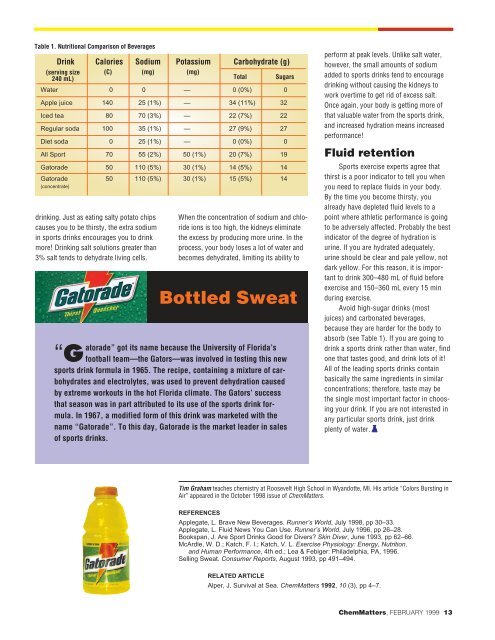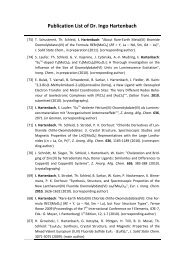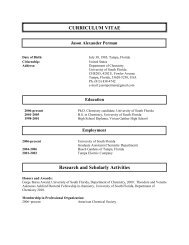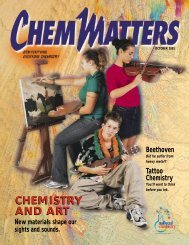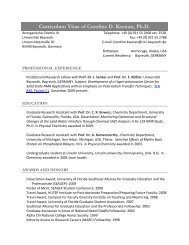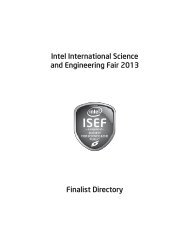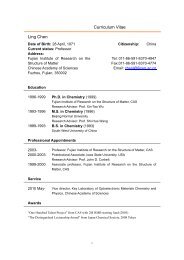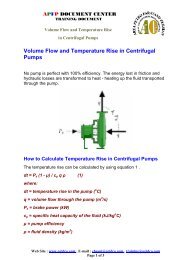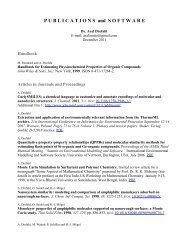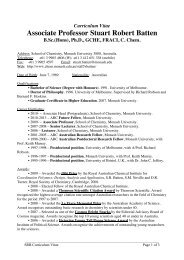Sports Drinks: Don't Sweat the Small Stuff - American Chemical ...
Sports Drinks: Don't Sweat the Small Stuff - American Chemical ...
Sports Drinks: Don't Sweat the Small Stuff - American Chemical ...
Create successful ePaper yourself
Turn your PDF publications into a flip-book with our unique Google optimized e-Paper software.
Table 1. Nutritional Comparison of Beverages<br />
Drink Calories Sodium Potassium Carbohydrate (g)<br />
(serving size<br />
240 mL)<br />
(C) (mg) (mg)<br />
Total Sugars<br />
Water 0 0 — 0 (0%) 0<br />
Apple juice 140 25 (1%) — 34 (11%) 32<br />
Iced tea 80 70 (3%) — 22 (7%) 22<br />
Regular soda 100 35 (1%) — 27 (9%) 27<br />
Diet soda 0 25 (1%) — 0 (0%) 0<br />
All Sport 70 55 (2%) 50 (1%) 20 (7%) 19<br />
Gatorade 50 110 (5%) 30 (1%) 14 (5%) 14<br />
Gatorade 50 110 (5%) 30 (1%) 15 (5%) 14<br />
(concentrate)<br />
drinking. Just as eating salty potato chips<br />
causes you to be thirsty, <strong>the</strong> extra sodium<br />
in sports drinks encourages you to drink<br />
more! Drinking salt solutions greater than<br />
3% salt tends to dehydrate living cells.<br />
When <strong>the</strong> concentration of sodium and chloride<br />
ions is too high, <strong>the</strong> kidneys eliminate<br />
<strong>the</strong> excess by producing more urine. In <strong>the</strong><br />
process, your body loses a lot of water and<br />
becomes dehydrated, limiting its ability to<br />
Bottled <strong>Sweat</strong><br />
atorade” got its name because <strong>the</strong> University of Florida’s<br />
“G football team—<strong>the</strong> Gators—was involved in testing this new<br />
sports drink formula in 1965. The recipe, containing a mixture of carbohydrates<br />
and electrolytes, was used to prevent dehydration caused<br />
by extreme workouts in <strong>the</strong> hot Florida climate. The Gators’ success<br />
that season was in part attributed to its use of <strong>the</strong> sports drink formula.<br />
In 1967, a modified form of this drink was marketed with <strong>the</strong><br />
name “Gatorade”. To this day, Gatorade is <strong>the</strong> market leader in sales<br />
of sports drinks.<br />
perform at peak levels. Unlike salt water,<br />
however, <strong>the</strong> small amounts of sodium<br />
added to sports drinks tend to encourage<br />
drinking without causing <strong>the</strong> kidneys to<br />
work overtime to get rid of excess salt.<br />
Once again, your body is getting more of<br />
that valuable water from <strong>the</strong> sports drink,<br />
and increased hydration means increased<br />
performance!<br />
Fluid retention<br />
<strong>Sports</strong> exercise experts agree that<br />
thirst is a poor indicator to tell you when<br />
you need to replace fluids in your body.<br />
By <strong>the</strong> time you become thirsty, you<br />
already have depleted fluid levels to a<br />
point where athletic performance is going<br />
to be adversely affected. Probably <strong>the</strong> best<br />
indicator of <strong>the</strong> degree of hydration is<br />
urine. If you are hydrated adequately,<br />
urine should be clear and pale yellow, not<br />
dark yellow. For this reason, it is important<br />
to drink 300–480 mL of fluid before<br />
exercise and 150–360 mL every 15 min<br />
during exercise.<br />
Avoid high-sugar drinks (most<br />
juices) and carbonated beverages,<br />
because <strong>the</strong>y are harder for <strong>the</strong> body to<br />
absorb (see Table 1). If you are going to<br />
drink a sports drink ra<strong>the</strong>r than water, find<br />
one that tastes good, and drink lots of it!<br />
All of <strong>the</strong> leading sports drinks contain<br />
basically <strong>the</strong> same ingredients in similar<br />
concentrations; <strong>the</strong>refore, taste may be<br />
<strong>the</strong> single most important factor in choosing<br />
your drink. If you are not interested in<br />
any particular sports drink, just drink<br />
plenty of water.<br />
Tim Graham teaches chemistry at Roosevelt High School in Wyandotte, MI. His article “Colors Bursting in<br />
Air” appeared in <strong>the</strong> October 1998 issue of ChemMatters.<br />
REFERENCES<br />
Applegate, L. Brave New Beverages. Runner’s World, July 1998, pp 30–33.<br />
Applegate, L. Fluid News You Can Use. Runner’s World, July 1996, pp 26–28.<br />
Bookspan, J. Are Sport <strong>Drinks</strong> Good for Divers? Skin Diver, June 1993, pp 62–66.<br />
McArdle, W. D.; Katch, F. I.; Katch, V. L. Exercise Physiology: Energy, Nutrition,<br />
and Human Performance, 4th ed.; Lea & Febiger: Philadelphia, PA, 1996.<br />
Selling <strong>Sweat</strong>. Consumer Reports, August 1993, pp 491–494.<br />
RELATED ARTICLE<br />
Alper, J. Survival at Sea. ChemMatters 1992, 10 (3), pp 4–7.<br />
ChemMatters, FEBRUARY 1999 13


